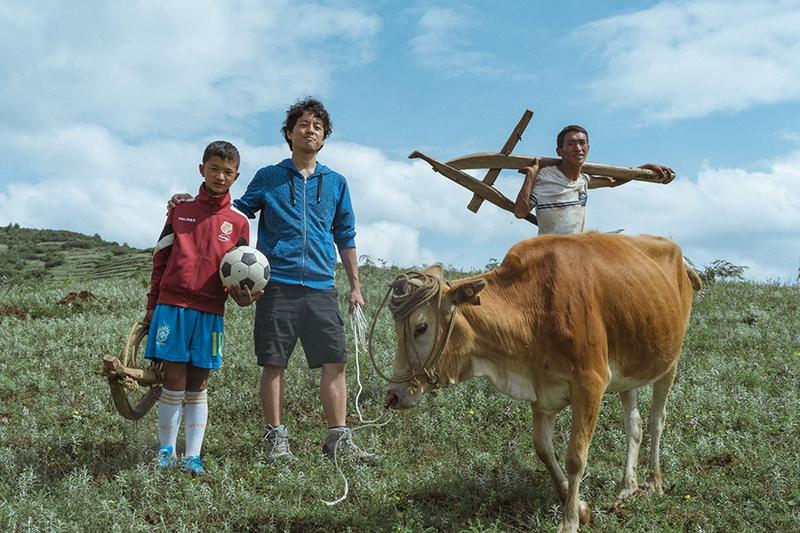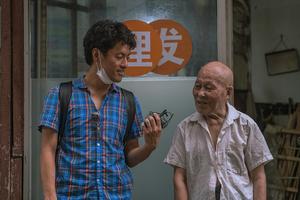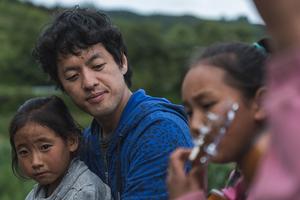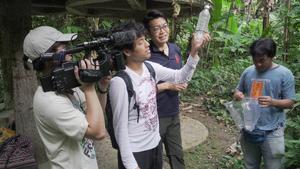Documentaries highlight efforts to fight pandemic and poverty
 Ryo Takeuchi poses with a fan in Liangshan Yi autonomous prefecture, Sichuan province. (PHOTO PROVIDED TO CHINA DAILY)
Ryo Takeuchi poses with a fan in Liangshan Yi autonomous prefecture, Sichuan province. (PHOTO PROVIDED TO CHINA DAILY)
A documentary about the impact of the pandemic in Wuhan, capital of Hubei province, has catapulted a Japanese filmmaker to fame on Chinese social media platforms.
Ryo Takeuchi, who has lived in China for seven years, found himself in the spotlight after making Long Time No See, Wuhan.
Many of my Japanese friends have biased opinions about Wuhan. As a foreigner living in China, and a documentary director, I really wanted to go to the city to show the world the real Wuhan
Ryo Takeuchi, Japanese filmmaker
Released on June 26, the film has been viewed more than 25 million times on Sina Weibo, China's largest social media platform. It has also been a hit in Japan, where it has notched up 940,000 views on YouTube.
To date, Takeuchi has 4.15 million followers on his Sina Weibo account, with Long Time No See, Wuhan winning the platform's Most Influential Documentary award this year.
After graduating from high school in Abiko, Japan, Takeuchi learned to make films at specialized schools. He worked for television stations as a documentary director before moving to Nanjing, Jiangsu province, with his wife, who is Chinese, in 2013.
His connections with China began in 2002, when he was in Shanghai and Zhejiang and Jiangsu provinces shooting a documentary about mahjong. Over the years, he has traveled frequently between China and Japan to make films.
"I liked watching movies in high school, even missing classes to do so. I like to record the real world, rather than follow a script, and that's why I chose to be a documentary director," he said.
Takeuchi, who is 1.73 meters tall, has curly hair and can speak fluent Chinese, is known as Liangshu (Uncle Liang) to his followers and fans in China.
"I never thought that Long Time No See, Wuhan would be such a hit in China," he said.
Representatives from some 100 media organizations in China and Japan interviewed him after the release of the documentary, he added. On the busiest day, he spoke to 14 media outlets.
Before rising to fame, Takeuchi had shot documentaries in China for six years, most of them subtitled in Chinese and Japanese.
His film The Reason I Live Here features the stories of hundreds of Chinese and Japanese living abroad.
"My inspiration comes from daily lives. A person will only get to know a place better if he or she lives there. I want to film China and get to know more about it. That is the reason I live in Nanjing," he said.
 Takeuchi interviews a resident in Wuhan, Hubei province. (PHOTO PROVIDED TO CHINA DAILY)
Takeuchi interviews a resident in Wuhan, Hubei province. (PHOTO PROVIDED TO CHINA DAILY)
Measures in Nanjing
Returning from a business trip to Japan in mid-February, Takeuchi had to self-quarantine at home in Nanjing. Later that month, COVID-19 began to spread in Japan, and he thought the measures taken in Nanjing to combat the disease could be useful for his home country and its people.
When the number of cases in Nanjing fell to zero, he set out to portray how residents were coping with the pandemic.
His 13-minute documentary Nanjing Fighting COVID-19 focuses on measures taken by the city regarding businesses, catering services, the subway, online car hailing services, tourist sites and quarantine for people returning from overseas.
Takeuchi said it usually takes at least three weeks to complete a film. However, he and his team spent just three days planning, shooting and editing Nanjing Fighting COVID-19.
"People in Japan and elsewhere urgently needed to know about the measures taken against COVID-19 here in Nanjing," he said.
Unlike Takeuchi's other films, in this documentary, he is the main character.
While filming at Nanjing's best-known tourist site, the Confucius Temple, also known as Fuzimiao, Takeuchi was refused entry because he does not have a Chinese ID card and is not registered with the local health code system.
The company he works for was required to take employees' temperatures three times a day. The readings were checked by community workers.
Nanjing Fighting COVID-19, first shown on Japanese television in March, features footage of Takeuchi's son taking physical exercise courses at home.
"I was surprised this film was so popular, as I was only recording my life here in Nanjing. Nearly all the Japanese TV stations showed it every day during March," Takeuchi said.
In the film, he states: "Of course, I'm not asking other places to copy the measures taken in Nanjing. I just want to inspire viewers to come up with policies that suit local conditions."
 Takeuchi listens to the folk music of the Yi ethnic group in Liangshan. (PHOTO PROVIDED TO CHINA DAILY)
Takeuchi listens to the folk music of the Yi ethnic group in Liangshan. (PHOTO PROVIDED TO CHINA DAILY)
Working in Wuhan
In a post on Sina Weibo, Takeuchi stated, "Many people told me not to go to Wuhan, because there might be more cases in the city than had been reported by the media.
"Many of my Japanese friends have biased opinions about Wuhan. As a foreigner living in China and a documentary director, I really wanted to go to the city to show the world the real Wuhan."
For Long Time No See, Wuhan, Takeuchi posted a notice on Sina Weibo, asking for volunteers. Hundreds of people applied to play the main character.
"Every resident in Wuhan has stories, so it was very difficult to choose. All the volunteers had great tales to tell, and we eventually chose 10 stories."
A lockdown was imposed in Wuhan, which has a population of more than 11 million, from Jan 23 to April 8 to prevent COVID-19 spreading.
At the end of May, mass nucleic acid testing was conducted on the city's residents.
Takeuchi said: "Some of my colleagues were opposed to the idea of shooting in Wuhan. The cameraman and photographer did not tell their families they were going to the city."
Departing from Nanjing South Railway Station on June 1, Takeuchi and the four other members of his team kept their nucleic acid test results with them for the 10 days they spent in Wuhan.
The main characters in the documentary are a deliveryman who continues to operate during the lockdown, the owner of a Japanese restaurant that closed for 133 days, and a junior high school teacher who used a drone to record scenes of Wuhan during the lockdown.
There is also a woman who had to close her leather products workshop, another who successfully reopened her milk tea store after the lockdown, a front-line nurse and the manager of a factory producing protective suits and face masks.
The cast is completed by a front desk employee at a hospital who lost her grandfather to the disease, a worker who took part in construction of the temporary Leishenshan Hospital, and a couple who were separated for more than 100 days.
Takeuchi said, "I didn't expect this film to be so successful, because it lasts for more than an hour, and many people now watch videos that run for only a few seconds."
He collected questions from Japanese netizens for people in Wuhan. Some asked if the city's residents would face discrimination from others living elsewhere.
Lao Ji, the deliveryman in the documentary, said: "I'm not afraid of discrimination, but I'm upset by it. Wuhan people made great sacrifices during the lockdown. It is not fair to call it the 'Wuhan virus'.This is wrong."
One night during filming, when Takeuchi had severe stomachache, an ambulance took him to the hospital, where he was found to have an 8 millimeter kidney stone.
"This experience made me aware of just how bad the situation was, as there were not enough doctors," he said.
"Lois M" posted on YouTube: "His work is so important for building empathy for humanity across the globe. I believe that the output of Takeuchi and his team is essential for a brighter future."
In another YouTube posting, Japanese netizen "Yoshiko Samamoto" stated, "This film reflects how strong Chinese can be when facing difficulties and also depicts the positive attitudes they hold for the future."
In the film, loved ones, businesses and sources of income are lost, but people continue to lead meaningful lives and look for new opportunities.
Takeuchi said: "I wanted to show the world what it was really like in Wuhan. However, I was also scared. We had these complicated and contradictory feelings as we started shooting, but afterward I just wanted to say that I definitely wished to visit Wuhan again."
Lai Yun, owner of the Japanese restaurant, said: "I volunteered to be a main character because I felt that many foreign media reports about Wuhan were biased. I wanted to use this chance to show our real lives."
Work on the documentary began on June 3-when coincidentally the restaurant reopened-and filming was completed the next day.
Takeuchi said that as Lai owned a car, they decided on the locations together and discussed the daily schedule.
Lai said: "The film is so realistic. There is no filtering and editing. It reflects the real lives of ordinary Wuhan people like myself."
In June, Xiong Yijun, the junior high school teacher in the film, said: "People might think everything returned to normal after the lockdown was lifted in Wuhan, but locals such as myself can sense the changes. The energy of the city has not returned.
"COVID-19 has made me learn more and think more about the city I was born and raised in. I found I might not have been as familiar with it as I thought, so a documentary like this can enable more people to learn about the real Wuhan."
Xiong added that her electric skateboard had been highly popular with Takeuchi, who rode it constantly during filming.
 A documentary is filmed by Takeuchi in Xishuangbanna, Yunnan province. (PHOTO PROVIDED TO CHINA DAILY)
A documentary is filmed by Takeuchi in Xishuangbanna, Yunnan province. (PHOTO PROVIDED TO CHINA DAILY)
Liangshan locations
Takeuchi has hailed China's poverty alleviation efforts, describing them as "eye-catching and of great significance".
"We want to go to these places to see the changes," he said.
Located in Sichuan province, Liangshan Yi autonomous prefecture is one of the country's poorest areas. The Yi ethnic group comprises more than 50 percent of the population, along with 13 other ethnic groups.
On a visit to the area about a decade ago, Takeuchi and his Japanese colleagues rode donkeys because there were no roads.
"We chose to shoot in Liangshan because our (Chinese) photographer used to teach at a school there as a volunteer and still has connections with it and many of the families," he said.
Takeuchi and his team contacted three interviewees before traveling to Liangshan in July.
"Audiences would be bored if the film was solely about poverty alleviation, so we began by shooting the scenery in Liangshan and also took footage of local delicacies," he said.
The team members stayed in Liangshan for 10 days, where they documented the daily life of a man from the Zhaojue county village of Atuleer, which stands at the top of a cliff.
They then filmed children and coaches from the Liangshan Football Program, sponsored by the Real Madrid Foundation last year in an effort to enhance local children's studies.
The main part of the documentary features the everyday lives of a family of four.
The 50-minute film will be shown on Sina Weibo and major video websites such as iQiyi, Tencent and Bilibili. It can also be viewed on YouTube and some Japanese television channels.
"Great changes have clearly taken place in Liangshan in terms of transportation, and I hope more people will get to know the area through this documentary," Takeuchi said.
"I have many favorite documentary directors, including Michael Moore. I like the humor and light approach to his work."
One of Takeuchi's most popular documentary series in China, The Reason I Live Here, marks its fifth anniversary this month. The director will hold events in Wuhan and Nanjing and invite some of those who appeared in the film to attend.
"Some netizens have said this series will end soon because there are no more stories to shoot, as we have already filmed more than 200 people (from China and Japan). But I will continue to film it because I want to convey Japanese culture to Chinese and Chinese culture to Japanese," Takeuchi said.
"I will never stop filming. It is the happiest thing for me."
He hopes that in the near future his films will be shown in cinemas throughout China.


